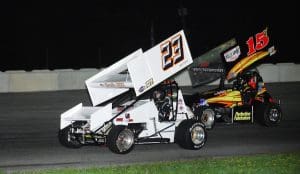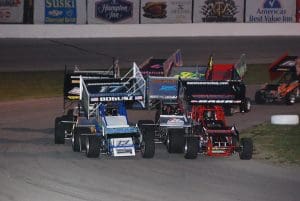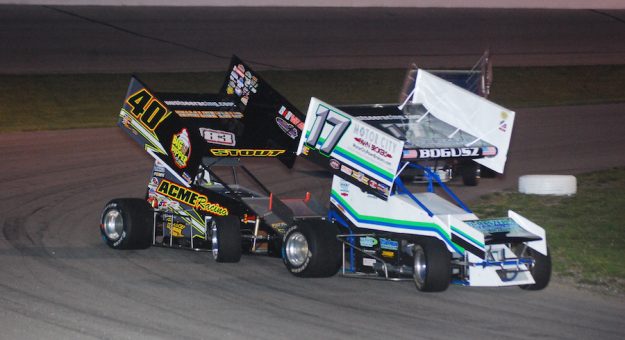As the Maxima Racing Oils Must See Racing Midwest Lights Series enters its fifth season, it’s full speed ahead for the 602 winged asphalt sprint car tour.
Racing primarily in Michigan and Ohio, the series continues to thrive while developing young drivers who at some point intend to move up to the Must See Racing 410 series. It’s a cost-effective, entry-level series with rules in place to maintain a level playing field without spending a substantial amount of money to be competitive.
For starters, the series uses a sealed 602-cubic-inch GM crate engine. The cars are four-bar dirt cars that must utilize standard shocks, not high-dollar adjustable shocks or coil overs. True purpose-built pavement cars aren’t allowed.
Utilizing dirt cars and standard shocks prevents teams from fully locking their cars down. They tend to run on the looser side, which has produced phenomenal racing the past four seasons.
The MSR Lights Series wasn’t started by design, but rather by necessity and circumstances. The division was being run weekly at Lorain Raceway Park in South Amherst, Ohio, with an occasional race at nearby Sandusky Speedway.
LRP closed following the 2019 season and was in the process of being sold. The teams realized they were without a place to race regularly.

Several teams approached Must See Racing owner Jim Hanks about possibly adding a series for 602 crates. There were high hopes a schedule could be put together with a decent number of races for the 2020 season.
“It was an opportunity that was presented to Must See Racing,” Hanks recalled. “What had happened was Lorain Raceway Park had already begun, and had in place, a 602-crate motor winged sprint car series.
“For whatever reason the series was OK, but the track was not. They were gonna go out of business, or he was gonna lose the track, whatever the circumstances were. I had previously met the track owner and he told me about the series.
“At about the same time, I got a few phone calls from the participants. At first, I didn’t have any interest in it,” Hanks continued. “But after giving it some thought, this thing answered a big problem we have in open-wheel, sprint car racing, giving our youth a place to race. In 2020, we had a meeting with all the guys that had participated in that series.
“We met at a restaurant in Lorain, Ohio. This was the same town where the track was, and where they had raced.
“I conducted the meeting and told them what I envisioned for the series and what Must See Racing was all about,” Hanks recalled. “The first thing we went over were our three objectives — safety, level competitive playing field and team cost-savings and containment. We have that with our 410 series and we’re working on that every single day, to this day. My objective for the MSR Lights Series was to bring in an entry-level, open-wheel series for everyone and get youth into our sport.
“We would travel but keep it affordable. But also, I wanted it to be a feeder system for our 410 series, with an asset base of equipment, that they could trade up if they wanted to go 410 racing. I explained to them that the most important thing was to create a series with the culture about us, not a me, me, me situation. That’s how it all started.”
Hanks provides an overview of an MSR Lights race car.
“An MSR Lights car is a dirt car configuration and we don’t let them move off that much,” he said. “It’s a four-bar dirt car. We’ve got straight up, as inexpensive as possible shocks. They got a 602-crate motor. We work with Race 1 out of Ohio. The bottom line is there are a lot of good pieces of equipment from dirt series across this country.”
The inaugural season didn’t go as planned when COVID-19 hit and the racing scene came to a screeching halt. Many series and tracks were forced to cancel their seasons. Must See Racing might was one of the luckier ones. Its schedule wasn’t completely wiped out, as the series completed three events.
The Lights series has proven to be competitive. There were three different champions in the first three years of the series – J.J. Henes, Joey Wyckoff and Cody Gallogly, respectively. It wasn’t until this past season that a previous champion (Gallogly) earned a second title.
There were three different feature winners in the six races the series contested a year ago. Gallogly, Henes and Andrew Bogusz each won at least one feature this past season. Three races were recorded and shown later on MAVTV.

“I was delighted with the way they raced that first year. I couldn’t have been happier with how close the competition was,” Hanks added. “To fast-forward to today, these are tremendous competitors.
“It’s family based and the culture is all about us. That makes it special and they have some great-looking cars. These guys are really, really holding up their end of the deal. I love the way they race.”
Late last year, Must See Racing lowered the minimum age requirement for the MSR Lights Series from 16 to 14.
“My reasoning for 16 in the first place was based on my experience being a car owner and being around the drivers and so forth,” Hanks said. “The simple fact is if they can’t get into our sport by the time they’re 16, they might already be gone to another form of racing. That was one reason.
“The other reason is there is a youth movement in car racing. Kids are starting a lot younger in karts and stuff. They have a lot more experience when they are younger, much younger. We have an owners’ council, and we review their experience and so forth.
“There are some very talented kids out there right now,” Hanks noted. “Just look at 14-year-old Colton Bettis down in Florida. He just won a winged sprint car race and beat who was billed the winningest pavement sprint car driver in the country last year, Davey Hamilton Jr. The kid earned it. He’s really a tremendous driver. I think because they are starting much younger and have more experience, we think it’s appropriate to lower that age.”
Hanks says the Lights series has accomplished its goal.
“This series is doing exactly what we want it to do. We just need to accelerate the growth from when we first started,” he said. “In our first year we had three events. We had eight or nine teams. We paid $500 to win and $300 for 10th place for instance, and we had $1,600 points fund. Fast-forward to 2024. We’ve got eight events and we’re hoping to have 17 teams.
“We’ve got 14 or 15 now, so there’s growth in that. Sixty percent of our races we pay $800 to win and we have a couple that pay $1,000. It’s now $450 to start. Our biggest growth is our points fund, which is now up to $6,000. The bottom line is everything about this, we’re very, very, happy with it. The immediate future for this series is very bright. These are good kids.”
THIS ARTICLE IS REPOSTED FROM THE MARCH 20 EDITION OF SPEED SPORT INSIDER
The SPEED SPORT Insider is an ad-free, subscription-only weekly e-magazine featuring stories, columns and exclusive archival content from some of the best writers in the business — Kerchner, Argabright, Bourcier, Holland, Sullivan and more.
Your INSIDER subscription helps support world-class motorsports journalism and is your ticket to insight, analysis and perspective you won’t get anywhere else. Subscriptions are just $5/mo or $44.95 for an entire year. View plans and details.

